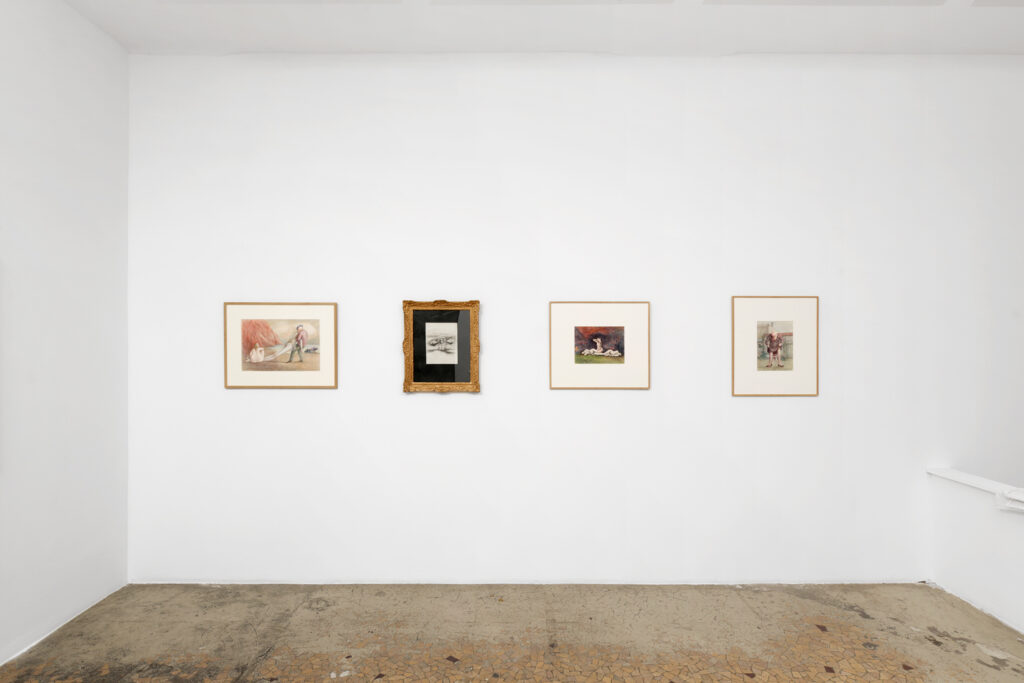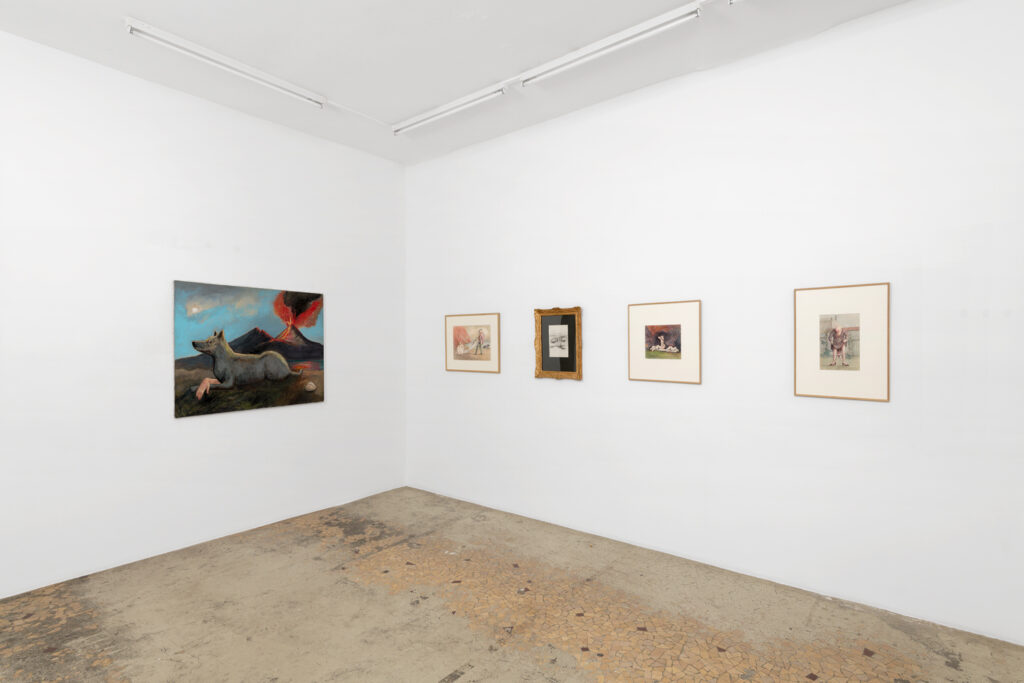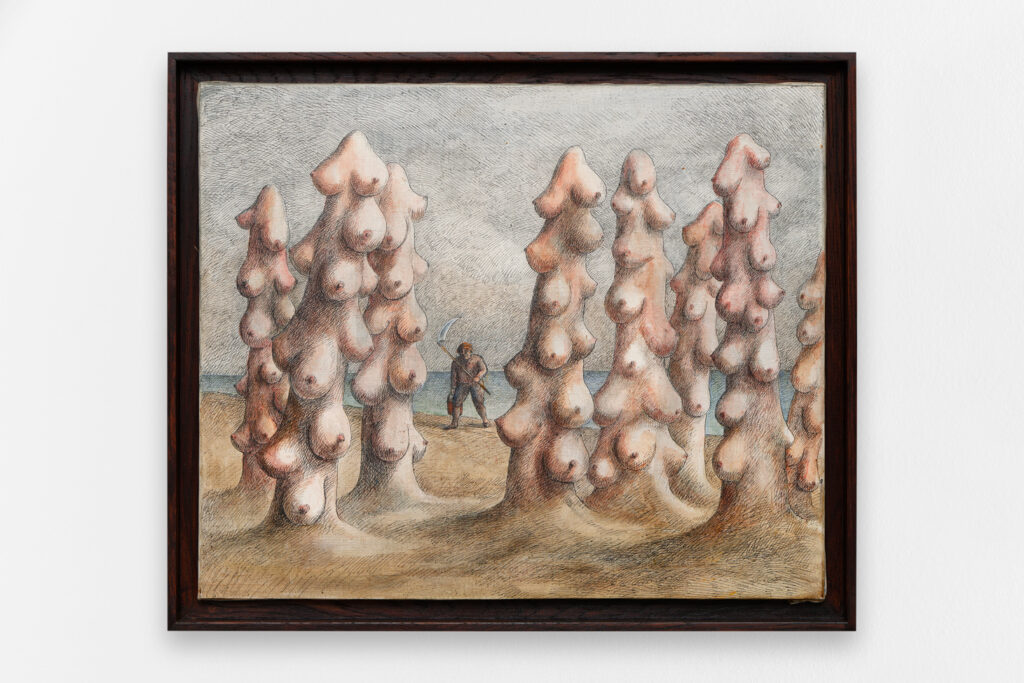TOPORISATION
François Piron
It may be useful today to remind what a national famous figure Roland Topor was in France in the sixties up to the nineties, and mainly in the seventies and the eighties, and not only in the cultural area.
On television, Topor is a regular guest, a “good customer” on the set, with a mocking retort and a thunderous laugh, and he also features in the writing of many popular TV shows: the parody sketch show Merci Bernard (1982-84), then Palace (1988-89), written and produced with Jean-Michel Ribes, but above all téléchat, 234 episodes of a children’s news program presented by the puppets of a cat and an ostrich talking with speaking objects, from 1983 [1] on. These television contributions however are for Topor only a tiny part of his work as a cartoonist, a writer, a stage director, but also an actor (for various film directors such as William Klein, Raul Ruiz, Werner Herzog or Volker Schlöndorff).
If Topor is an integral figure of the media show, he is also fully a part of the post-war Parisian avant-garde history, in the wake of Surrealism and near the Collège of pataphysique. Such is the paradox of his career: both “mainstream” and “underground”, he does not fit in any category of the “fine arts”, which probably explains his marginal place today in their history, but he borders all these categories, and freely defines his consistent going back and forth between them : a ferocious sense of humor, an ironic defiance towards prevailing aesthetical conventions, and a concern to address an audience beyond the established, right-thinking and legitimating circles.
It is the chance of a first publication that brings Topor into the surrealist sphere. The publisher Jean-Jacques Pauvert, who publishes Sade and Bataille, and republishes L’Anthologie de l’humour noir by Breton, chooses a drawing by Topor for the cover of the 9th issue of his magazine Bizarrein 1958 [2]. While still a student at the Fine Arts School of Paris, Topor comes into contact with some Surrealists, of whom he says: “ you were not allowed to sneeze when Breton was prophesying, bullshit was severely punished; you were not allowed to choose your friends” [3]. His taste is rather to be found in Belgian Surrealism, between the sarcastic and obscene subversion of Marcel Mariën and the “tactical conformism” of René Magritte. One of Topor’s first commissions will be the cover of a book of the writer André Blavier, the future specialist of “literary madmen”: De quelques inventions belges utiles et tolérables, in 1960.
The publication in Bizarre, which will not happen again, nevertheless amounts to affiliation. Topor turns to the press, humorous drawings and satirical cartoons, particularly for the magazine Hara Kiri. In 1961, his meeting with two other exiles, the Spanish Fernando Arrabal, and the Chilean Alejandro Jodorowsky, with whom he is going to create his own group, Panique, is a turning point for him. Panique is not a closed group, but rather a circle of friends, with a variable configuration and no structure [4]
: it is not a slogan, but rather a password, like the Collège of patathysique [5]
; an entity with skillfully blurred contours, but whose members will claim their membership all their life. Since it has never really existed, they say, there is no reason to disband it.
In 1965 and 1966, several performances of the group Panique, orchestrated by Arrabal, Jodorowsky and Topor are shown at the Festival de la Libre Expression, organized by the artist, Jean-Jacques Lebel, at the American Center, rue de Bercy, in Paris. Topor’s performance, in 1965, is entitled “ Cérémonie pour une nouvelle femme” [6] (Ceremony for a new woman): actors in bowler hats handle cardboard objects. Topor made masks, costumes and large drawings stuck on wooden figures, which interacted with the actors. A dancer did a striptease around a giant plaster breast before it was trampled and thrown off the stage. Opening his thighs, a hooded monk pourred the content of an aquarium over her crotch, etc.
With these performances, Topor is on the verge of the contemporary art world. He shares the poster for the Festival de la Nouvelle expression (the Festival of the New Expression) with Nam June Paik and Charlotte Moorman; he frequently sees Daniel Spoerri and illustrates his book, An Anecdoted Topography of Chance, published by Emmett Williams for his publishing house Fluxus Something Else Press in 1966.
Through Spoerri, Topor meets Robert Filliou and Erik Dietman, but above all friendship guided these encounters, while he is on the sidelines of the art world, toward which he is most suspicious: “ Most of the time artists are said to be producers of luxury products (…). I decline prestige, because I do not think it is so much more noble and prestigious to work and trade in art than to make and sell shoes or prepare meals, or go through garbage. (…) I do not say that out of demagogy. It is the product side, the object to be had that makes me uncomfortable. Many art works are not necessarily very novel or inventive. (…) On the whole they only are the insidious instruments of power, because they reinforce it in the stupidest way.” [7]
His Mémoires d’un vieux con (the Memoirs of a schmuck) is a fictionalized autobiography of his life as an artist, in which he ridicules the image of the artist and the conventions of the art world: “my remarkable gifts for plastic arts appeared from my earliest days. I already showed an exceptional talent. Three years old, I was carving Klee sketches with my fork into mashed potatoes, to my family’s amazement…” [8]
To a consistent precise artistic line, Topor preferred to multiply the fields of expression, often on commission, working for the press, cinema and television. In 1978 he even accepted a commission from the CNPF (National council of French employers), before it became the Medef (National confederation of French employers), for a short-length animation film about the business world. But after a few drawings depicting the factory as a greedy animal devouring human beings, the commission was cancelled. The spirit of Hara Kiri lives on in the conclusion of his Mémoires d’un vieux con, taking the form of an apology of opportunism: “Long live money! Long live avant-garde! Long live communism!” [9]
Topor has developed a rejection of “modern art” based on a legitimizing discourse and distinction, meant for the pacified world of museums. He prefers a popular approach to art, which causes laughter and shock, as so many devaluations of the “grand art”. Jacques Sternberg, in his preface to Topor’s first collection of drawings, Les Masochistes, did not fail to point it out : “to go so far in the lack of measure and good taste, when good manners are the key to success and intellectual esteem. Monsieur Topor, I do tell you, you must seriously detoporise yourself if you want to get somewhere, to succeed, as they say.”
[1] Roland Topor directed Téléchat with Henri Xhonneux, with whom he collaborated again for Marquis (1989), a feature-length film, also with puppets but not for children, about the life of the Marquis de Sade.
[2] Topor would later define Bizarre as “a sort of catch-all in the surrealist vein, between the unusual, the incongruous, the marvelous and the derisory”, in “Les Oreilles et la queue”, interview with Bernard Corteggiani, Les Inrockuptibles, no. 37, July 1992. This first drawing published by Topor shows two men sitting side by side at a table. One is impassive, his gaze blank; the second is already dead, face down on the surface of the table, next to him a black cube; above his neighbor, the same cube, a few thousandths of a second from impact. No caption, no signature, but a legible inscription in André Breton’s concept of black humor.
[3] Frantz Vaillant, Roland Topor ou le rire étranglé, Paris, Buchet-Chastel, 2007, p.114.
[4] No real list of Panique’s members has ever been drawn up. In addition to Topor, Arrabal and Jodorowsky, those who have been members include Olivier O. Olivier, Diego Bardon, Sam Szafran, Michel Troche, Jacques Sternberg, Abel Ogier, Dominique Sevrain, André Ruellan, Christian Zeimert, Jérôme Savary, Kazik Hentchel, Zwy Milstein, Yojiro Otsuki, Heidi Draper, Michel Parré, Freddy de Vries, Bob Swain, Copi, Jean Benoit, Mimi Parent, as well as graphic designer Roman Ciezlewicz, editor of Kamikaze, a panic news magazine whose first issue, was published by Christian Bourgeois in 1976. [5] Topor n’a été nommé Satrape du Collège de ‘pataphysique qu’à titre posthume, en 2001.
[6] The performance was recorded and broadcast on television in “Happening”, a report directed by Jean-Pierre Mirouze, aired on January 1, 1965. [7] Roland Topor, Courts termes, en aparté avec Eddy Devolder, Creil, Dumerchez, 1994, p.18
[8] Roland Topor, Mémoires d’un vieux con, Paris, Balland, 1977, p.11
[9] Mémoires d’un vieux con, p. 177
[10] Roland Topor, Les Masochistes, Paris, Le Terrain Vague, 1960




Roland Topor
Oh la la, 1973
color pencil on paper
24 x 32 cm / 55 x 63 cm (framed)

Roland Topor
L’île nue (ou Nouvelle récolte), 1973
oil and ink on canvas
54 x 65 cm / 61 x 72 cm (framed)
